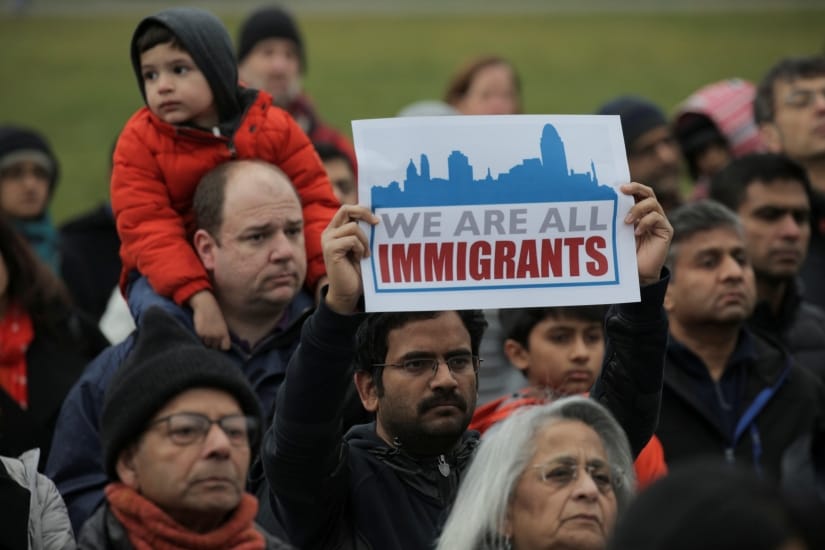Migrant wives: The harsh reality of Indian H4 visa holders, who must remain dependent on spouses or live illegally
The cover picture on Rashi Bhatnagar’s blog ‘H4 Visa, A Curse’ says it all. It depicts a woman sitting distraught in a golden cage. Rashi lived in the US for over 10 years before she started her blog. She says she chose the name ‘H4 Visa, A Curse’ “because it is not people’s choice that they are unable to work. It is a strange situation that has been imposed by the US government on immigrants.” The H4 visa situation, she writes in the introduction to her blog, “includes various implications like domestic violence, financial dependence, no identity, breaking up of families, legal H4 visa children leaving their families, skilled H4 visa holders being inhibited to work or start any business for 10-15 years. That is indeed a curse!”
Meghna Damani coped with her frustrating immigration experience in another way. Her film Hearts Suspended is based on her own experience as an educated professional woman with a H4 visa who was almost driven to suicide because even after five years of living in the US, she could not get a job. She finally enrolled in a filmmaking course. In 2011, she decided to make a film on others like her who were unable to work or become financially independent.
Visa Wives was written by journalist Radhika MB, who had worked in several prestigious publications in India before she followed her husband to the US and became jobless. Her book, which is about the emigration experiences of Indian women in the US, contains plenty of information as well as interviews with women caught in the claustrophobic trap of the dependent visa. She also writes about women who lived financially and socially independent lives in India but suddenly found themselves dependent on their husbands for every single thing, from buying groceries to opening a bank account. All these smart women, who would have pursued great jobs in their own country, have become extremely frustrated after they relocated and are now trying to help others in similar situations to cope.
Statistics indicate that 94 percent of H4 visa holders are women, and of these, 93 percent are from India. Almost all of them knew that following an H1B holder husband to the US would either put an end to their professional careers or at least cause a huge gap which would affect their career graphs adversely. But they still took the plunge, hoping the lay-off period would be short, and that as professionals, they would be able to get jobs and find sponsors who would get them an H1B visa too. Many H4 visa holders who landed in the USA were newly-weds with no job experience, but they were hopeful of new lives and careers in the land of opportunity.
By 2015, the Obama government had realised that a large educated and skilled work pool which was going to waste could be put into action with a little tweaking, and so, in May 2015, the Employment Authorisation for Dependent spouses rule was passed. H4 dependent spouses applying for authorisation under this rule had to satisfy certain criteria. Armed with the new EAD (Employment Authorisation Document), they could go to work or set up their own businesses. This was exciting news for those who had spent years in limbo.
Thousands of H4 visa holders applied for the document, and by 2018, more than 100,000 had got it. Of these, most were now gainfully employed. Some had even invested money and set up their own businesses, but all the while, the sword of Damocles was hanging over their heads, threatening to come crashing down any moment. Save Jobs USA, an anti-immigration group of employees who claimed they had lost their jobs to H1B workers, had filed a lawsuit against the US Department of Homeland Security (DHS) as soon as the rule was introduced. Three years later, it looks as if they could win the case. Given the Trump administration’s stance on immigration, this is an outcome which seems most likely.
What then will happen to the EAD holders who have got jobs and started earning well? And to those who have bought houses hoping to pay off mortgages, now that they are double income families? What happens to the businesses some have started by investing their life’s savings? Their situation can be dire if this rule is revoked. They cannot go back to India because they have invested too many years of their lives in the US and are waiting for the elusive green card. The prospect of having to return to joblessness is equally unacceptable.
If a woman on an H4 visa loses her husband in an accident, due to a racial attack or due to medical reasons, she too is pushed into a corner. A much publicised case was that of Srinivas Kuchibhotla who was killed by a racist man while he was quietly sitting in a bar in Kansas. His wife Sunayana Dumala was shattered. She had not only lost her life partner and the man she loved most, but she had also lost the only means to earn a livelihood and the right to continue living in the country. She was able to salvage her life with the help of her Congressman. But not everyone is so lucky. Many women are either forced to go back to India or somehow disappear under the radar and join the large community of illegal Indian immigrants working in underpaid jobs and living in the hope of getting naturalised one day.
The number of undocumented Indians in the US in 2009 was estimated at around 350,000. By 2014, it had gone up to 500,000. According to Quartz, the number of Indians who overstayed their visa in 2015 alone was 14,000. There are no proper estimates of how many undocumented Indians there are in the US, nor is there enough information about how they survive or where they live.
Chirayu Patel describes himself in his Twitter bio as a “DACAmented American” who is “Advocating DREAM Act & not1more deportation.” He says he is determined to live “in the only country I call home.” Chirayu came to the US in 1994 when he was 11 along with his parents. His father had a valid work visa, but the family became illegal immigrants when they overstayed. He was not even aware of this until he went to college and had to apply for funding. He then found he had no social security number and was not a legal immigrant.
Like other children of “undocumented” immigrants, Chirayu could temporarily benefit from the Deferred Action for Childhood Arrivals (DACA) immigration policy introduced by Obama. This allows some individuals who were brought to the United States illegally as children to receive a renewable two-year period of deferred action from deportation and become eligible for a work permit and social security number in the US. The policy was announced by President Barack Obama in 2012 to help these young people called the Dreamers after the DREAM (Development, Relief, and Education for Alien Minors) Act which was introduced in 2001, but never passed. About 5500 Indians today are on DACA status. Although many more are eligible, most of them are afraid of registering as they do not know what the consequences will be. They are also wary of having to get their status renewed every two years. This is especially true of single women who have been abandoned or have run away from bad marriages. But this Act too might be revoked. In fact, a couple of months ago, President Trump declared it dead.
Bhavani is an undocumented Indian who had escaped from the house of her cruel Indian employers in New York. She was just 15 when she was brought into the country. She has no idea about whether her employers brought her in legally or not, since they had confiscated her passport and papers. She has no money and no hope of ever going back home to India. She also has no idea about any relief measures which might have been offered or withdrawn. Bhavani, who is now around 30 years old, lives in a community with other similar immigrants who have no papers. She is married with two children and works as cook’s assistant in an Indian restaurant.
Going back to India is no longer an option. She has lived in America for too long. She has become used to keeping a very low profile. America is the only home she has. She has had no communication with her family in India for over ten years. “If I am deported,” she asks, “where will I go?
The article first appeared in Firstpost.com




